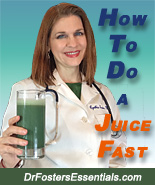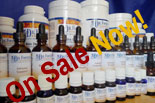Doctor sheds light on the New England Journal of Medicine study on echinacea efficacy.

Los Angeles, CA. (Sept 7, 2005) - Doctor finds failings in the recently released study on echinacea (Echinacea angustifolia), as reported in the July 28, 2005 issue of the New England Journal of Medicine (NEJM). Two of the researchers have financial arrangements with manufacturers of antibiotics, antibacterial soaps, facial tissues and over the counter cold and flu remedies, and other organizations, an obvious conflict of interest. Furthermore, news reporting of the study findings without adequate investigation has also misled consumers.
According to this most recent study, echinacea was reported to be an ineffective preventative and treatment for the common cold. This study is in contradiction to a large body of research that has found echinacea to be an effective defense against colds and flus. Yet, on the day this study was released, CNN reported on their website CNN.com "No Comfort For Colds" as their headline, leading off their article with, "Treatments that don't work made medical news this week." CBS News reported, "Study Debunks Echinacea's Powers," and NBC's Bob Faw stated that the study concludes, "When it comes to fighting the common cold, you're better off slurping chicken soup."

Field of Echinacea Flowers
Dr. Foster states, "The extracts used in this study were of a weaker strength than what is typical for over the counter Echinacea products. The preparations were made from the dried root, which is considered a poor quality source of herbal materials according to leading herbalists who recommend the fresh root. The low potency of the dried preparation and the extraction techniques they used are also in question. According to the published article in NEJM, not a single one of the 3 types of extracts contains all of the known active components of echinacea angustifolia in the proper proportion in order to be considered a quality extract.
One active component, echinacoside was completely absent from all three extracts." Yet, in a different earlier study on echinacea, Dr. Bauer's group of researchers had performed a complete analysis of the components in echinacea angustifolia and confirmed the presence of echinacosides. The fact that none of these extracts contained echinacosides in a root that is known to contain them should make us question the quality of the extracts the researchers used.

Liquid Herbal Extract
One of the extracts used in this study was a 20% alcohol extract. A 20% alcohol solution does not contain a high enough percentage of alcohol to extract the medicinal components from a dried echinacea root. A 20% alcohol solution is simply used as a preservative for pressed echinacea juice, which is taken from the more delicate aboveground parts, not the denser root. Roots are the densest part of an herb, and require a higher percentage of alcohol in order to extract their active ingredients.
"I'm not surprised that this particular extract was the lowest in active components, and with this weak of an extract, I wouldn't expect it to have any benefit at all." says Dr. Foster. She adds, "No American herbalist would use a 20% alcohol solution to extract anything from a dried herb. Any professional herbalist who used this low of an alcohol percentage to make an extraction from a dried root would be considered incompetent by the American herbal industry."
Generally speaking, most liquid extracts in the United States are made with an alcohol solution ranging from 40-55% since this is the ideal percentage of alcohol that extracts the most healing components from therapeutic herbs, and echinacea root should be extracted in a solution that is at least 60% alcohol (but preferably higher) in order to be effective.
Another extract used was a carbon dioxide supercritical extract. This type of extract is not widely used in America, due in part to the expensive, specialized machinery required to make this type of extract. Since supercritical carbon dioxide extracts are, for the most part, not available in the U.S., the results from this extract cannot be applied to what is commercially available for American consumers.
The researchers also did not tell us how old the roots they used were. Echinacea is at its maximum effectiveness when it is harvested at 3 years of age or older. Younger roots are sometimes used because they are less expensive, but they are less effective.
The researchers also did not add what percentage of herb they used relative to the alcohol. Did they follow U.S. Pharmacopeia Guidelines? The U.S.P. sets national standards for medicines and dietary supplements worldwide. If they didn't use enough dried root in the alcohol, the extract would be too weak and ineffective. Also, how was the root dried? Was it flash-dried, spray-dried, shade-dried or dried in the sun? Each of these drying methods can affect the potency of the dried root.
The dose of echinacea used in the 7/2005 study is much lower than the average dose suggested on echinacea labels sold in stores. The recommended dose of echinacea according to the British Herbal Pharmacopoeia is 500 mg to 2 grams three times daily for a total of 1.5 to 6 grams total dose daily. The dose used in the study was 300 mg three times daily for a total daily dose of 900 mg, or a mere 0.9 grams daily. Even the World Health Organization recommends a dose (1000 mg three times daily, or 3 grams total dose daily) that is 3 times higher than what was used in this study. Researchers appeared to follow German Commission E recommendations for Echinacea pallida, but not for the species angustifolia.
The researchers' methodology was also questionable. The squirting of a concentrated dose of monkey kidney cells infected with the rhinovirus directly into the nose is not the way the average consumer would ever be exposed to the virus. The unnatural nasal rhinovirus challenge has been used in previous studies with questionable results. In one of these studies, a firmly established method of preventative treatment, vitamin C, was also claimed to be ineffective for preventing the onset of the common cold.

Hands Pass Cold and Flu Viruses
The nasal challenge method seems unnecessary especially since researchers such as Dr. Gwaltney established in 1978 that hand-to hand transmission of the virus was an effective way of causing study volunteers to catch the cold. (Gwaltney et al. Ann Intern Med. 1978 Apr;88(4):463). Hand-to-hand transmission involves transferring the virus to volunteers' hands who then try to infect themselves with the virus by sticking their fingers in their nose. Interestingly enough, Gwaltney's study is quoted by Dr. Turner in his earlier research studies. Furthermore, Dr. Turner himself has used the hand-to-hand transmission route himself in an earlier 2004 study on organic acids in hand cleansers (see this study and note at the end that it was funded by Procter & Gamble, makers of Safeguard antibacterial soap).
In reference to 2 of the researchers (Dr. Turner and Dr. Gangemi) of the most recent echinacea study, they were also involved in a similar echinacea study which was previously done in June of 2000. That study was funded by Procter & Gamble who had an obvious conflict of interest: they benefited from the discrediting of echinacea, which is in direct conflict with their cold and flu medicines, including Vicks VapoRub®, Vicks BabyRub®, Vicks 44®, Vicks 44E®, Vicks 44D®, Vicks 44M®, Pediatric Vicks 44®, Vicks Vapor Inhaler®, Vicks VapoSteam®, Vicks Cough Drops®, Sinex®, Sinex 12 hour®, Sinex Ultra Fine Mist®, Sinex 12 hour Ultra Fine Mist®, Nyquil®, Nyquil Cough®, Dayquil®, and Dayquil Sinus®.
The lead researcher of the 7/2005 echinacea study as well as the abovementioned 6/2000 study funded by Proctor & Gamble was Ronald B. Turner, MD. Dr. Turner has known financial arrangements with leading manufacturers of over the counter cold and flu medicines. These arrangements are disclosed at the end of many of his research studies and are no secret. (look under "Acknowledgments" to see who funded the earlier 2000 echinacea study) These disclosed financial contributors have a leading share of the market in the sale of allergy, cold and flu remedies. They include Wyeth Consumer Healthcare, makers of Dimetapp®, Robitussin®, Advil® , Alavert®, and Primatene®; Schering Plough, makers of Clarinex®, Nasinex®, Proventil®, Afrin®, Claritin®, Clortrimeton®, and Drixoral®; as well as Procter & Gamble. These are the corporations that could lose revenues when consumers take echinacea or other natural products.
A third researcher involved in the 7/2005 echinacea study, Dr. Bauer, was previously involved in a randomized, double-blind, placebo-controlled research study (see the study: scroll to the "Discussion" section to see their results) in February of 2004. In this study, the pressed juice of echinacea purpurea was used and it was found to be quite effective in reducing by 23.1 % the daily symptoms of the common cold. However, in this study, fresh echinacea was used, not the dried. Additionally, the dose was much higher and taken many more times daily (4 ml ten times daily on the first day and 4 ml four times daily for the following 6 days).
One wonders why the NIH would grant the $2.2 million it took to do this study that was led by a researcher who has so many "financial arrangements" with echinacea's competitors. Dr. Turner has written several articles in the past on the ineffectiveness of echinacea. If they would have researched his previous review articles, they would have found that he already believed echinacea didn't work for the common cold. A study led by a researcher who has a predetermined opinion of the effectiveness of what he is testing is not exactly an impartial unbiased research study.
Another of Dr. Turner's financial contributors is the Dial Corporation. The Dial Corporation, the makers of Dial® soap, apparently does not have an interest in promoting an herbal product that would reduce the frequency and severity of colds and flu. The Dial Corporation is interested in selling more antibacterial soap during cold and flu season. In their advertising materials regarding colds and flu, they claim that proper hand washing is the "best way" to help prevent the spread of germs during cold and flu season.

Suffering From a Winter Cold
Procter & Gamble also makes Puffs® tissues. If people used echinacea to successfully fight off colds, they would be using less facial tissues. An interesting side note: Dr. Turner, Procter & Gamble's paid consultant, was quoted last week as saying that the research shows that antiviral tissues don't work. Really? I'll quote his 2004 study on organic acids in hand cleansers: "A combination of citric acid, malic acid, and sodium lauryl sulfate incorporated into a nasal tissue is virucidal for a broad spectrum of rhinovirus serotypes. Use of these tissues reduced the person-to-person transmission of rhinovirus infection under experimental conditions." Puffs® does not make antiviral tissues, but Kimberly Clark, Puffs®' competitor does. They recently introduced their Kleenex® antiviral tissues. They list the ingredients as citric acid and sodium lauryl sulfate. What an interesting coincidence. Procter & Gamble didn't seem to be able to bring out their antiviral tissues this year. Maybe next year.
Annual sales of echinacea have climbed steadily from $70 million in 1998 to $72 million in 1999 (according to the Trade magazine Drug Store News), to estimates of around $155 million in 2004 (According to Nutrition Business Journal). $4.3 billion were spent on herbal sales in 2004. The study's corporate contributors are concerned about potential lost revenues, not the effectiveness of echinacea.
The study's own authors concluded that it would "be difficult to provide conclusive evidence that echinacea has no role in the treatment of the common cold" due to the great variety of echinacea preparations available. Yet the news media poorly reports or contradicts the authors by claiming that echinacea offers no clinical benefit whatsoever in the treatment of the common cold. Either they did not thoroughly investigate the study or they underreported the findings, thereby misleading the American consumer into thinking that echinacea is of no benefit for the common cold.
Dr. Foster is not alone in her concerns about the design and execution of the 7/2005 research study on echinacea. Other organizations such as the American Botanical Council and the American Herbal Products Association agree that this study was faulty and misleading.
Let the consumer be wary of research studies whose researchers have financial contributors with a known conflict of interest. Let them be wary of medical journals whose editors allow poor studies to be published and of government agencies who provide grants to researchers who are biased due to financial conflicts of interest. Let them beware of news agencies who do not properly report the results of scientific research studies.
About the author:
Dr. Cynthia Foster, M.D.
A Conventionally Trained Medical Doctor Who Left Medicine Almost 20 Years Ago to Practice 100% Holistically
 After receiving a required Hepatitis B vaccine for entry into medical school, Dr. Cynthia Foster became severely ill with grand mal epileptic seizures. The seizures occurred twice daily for almost four years – almost the entire time she was in training to become a conventional medical doctor at the University of Texas Health Science Center. Putting her life into the hands of a very experienced holistic nurse who was using holistic healing methods with unprecedented and extraordinary results, she refused all medications or other medical interventions for the seizures.
After receiving a required Hepatitis B vaccine for entry into medical school, Dr. Cynthia Foster became severely ill with grand mal epileptic seizures. The seizures occurred twice daily for almost four years – almost the entire time she was in training to become a conventional medical doctor at the University of Texas Health Science Center. Putting her life into the hands of a very experienced holistic nurse who was using holistic healing methods with unprecedented and extraordinary results, she refused all medications or other medical interventions for the seizures.
Using only natural methods as her treatment, the seizures went into complete remission, and she has been seizure-free for over 20 years. Her first book Stop the Medicine tells the incredible story of her miraculous recovery as well as giving a behind-the-scenes look at the Modern Medical Establishment. In her search for healing, she has traveled the world learning and incorporating natural methods into her holistic practice, including herbal detox, natural supplements, aromatherapy, hydrotherapy, energy healing, mind-body medicine, healing visualizations, juice fasting and therapeutic foods.
After receiving her MD degree, and refusing to practice medicine because of the miraculous healings she had seen in others and experienced for herself, she began her practice using only natural methods to heal her patients, specializing in teaching people how to heal themselves with simple remedies and techniques, and has been able to repeat the miraculous healing results with her patients that she herself had personally experienced.
Over the past 20 plus years, she has served many roles including not only healing practitioner, but also herbal product trainer and spokesperson for herbal product companies, and also founded her own pharmaceutical strength herbal product line called “Dr. Foster’s Essentials” to address the health problems she was seeing in her practice. She noticed over a period of two decades of seeing patients, that they usually brought her grocery bags full of so-called “natural” supplements that simply did not work. She founded Dr. Foster’s Essentials, insisting on including herbal extracts up to ten times stronger than what is traditionally available in grocery stores, drug stores health food stores, and even online, as she felt these “mass-marketed” remedies were too weak and watered down to heal anything as serious as what she had experienced with the epilepsy.
A highly sought after speaker and university instructor, she has lectured worldwide on a wide range of topics from the use of herbs to emotional healing to conventional medicine classes for acupuncture students. She has been interviewed numerous times on radio programs and mentioned in the press as well as featured in magazines, newspapers, and on television. Current projects include a second book describing how to use herbs and natural healing techniques to overcome life-threatening, chronic and incurable health issues.
|
Learn More: |
"The Race Is Not Always To The Swift,
But To Those Who Keep On Running."
-Anonymous













